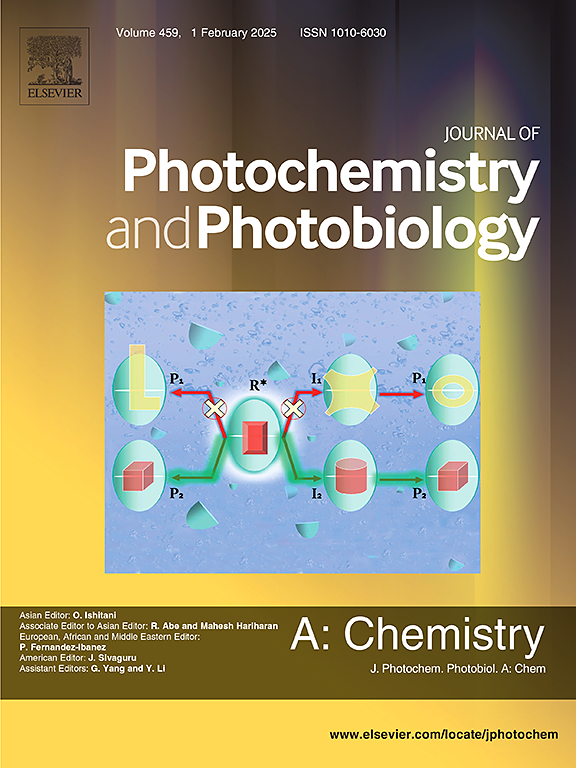Photoreactivity of 1-azidostyrene and 3-phenyl-2H-azirine in acetonitrile and cryogenic matrices
IF 4.1
3区 化学
Q2 CHEMISTRY, PHYSICAL
Journal of Photochemistry and Photobiology A-chemistry
Pub Date : 2025-04-03
DOI:10.1016/j.jphotochem.2025.116427
引用次数: 0
Abstract
Despite their versatile synthetic utility, vinyl azides have complex and poorly understood photochemistry. To address this, we investigated the photoreactivity of 1-azidostyrene 1 and 3-phenyl-2H-azirine 2 in solution and cryogenic matrices. In argon matrices, irradiation of 1 at 254 nm yielded 2, phenyl nitrile ylide 3, and N-phenyl ketenimine 4, whereas irradiation at wavelengths above 300 nm produced only 2 and 4. Similarly, irradiation of 1 in 2-methyltetrahydrofuran (mTHF) glass at 77 K mainly yielded absorption corresponding to the formation of 2 (λmax ∼ 252 nm). In contrast, irradiation of 2 at wavelengths above 300 nm in Argon matrices yielded no photoproducts, whereas irradiation at 254 nm resulted in the formation of 3. Furthermore, femto- and nano-second transient absorption and laser flash photolysis were performed to ascertain the transient species and reactive intermediates formed during the photochemical transformations of 1 and 2. The ultrafast transient absorption spectroscopy of 1 resulted in a transient absorption band centered at ca. 472 nm with a time constant τ ∼ 22 ps, which was assigned to the first singlet excited state (S1) of 1. The nano-second flash photolysis of 1 (308 nm laser) generated 2 within the laser pulse (∼17 ns), and subsequently 2 is excited to yield triplet vinylnitrene 31N with an absorption centered at ∼ 440 nm. In contrast, the nano-second laser flash photolysis of 2 with 266 nm laser produced a weak absorption corresponding to 3, whereas 308 nm laser yielded absorption due to triplet vinylnitrene 31N (λmax ∼ 440 nm). These findings demonstrate that the direct irradiation of 1 populates S1 of 1, which does not intersystem cross to form 31N, but instead decays to yield 2. Density functional theory calculations supported the characteristics of the excited states and reactive intermediates formed upon irradiation of 1 and 2.

1-叠氮苯乙烯和3-苯基- 2h -氮嘧啶在乙腈和低温基质中的光反应性
尽管它们具有多种合成用途,但乙烯基叠氮化物具有复杂且鲜为人知的光化学。为了解决这个问题,我们研究了1-叠氮苯乙烯1和3-苯基- 2h -氮嘧啶2在溶液和低温基质中的光反应性。在氩气基质中,254 nm处辐照1产生2、苯基腈基3和n -苯基酮亚胺4,而300 nm以上辐照只产生2和4。同样,1在2-甲基四氢呋喃(mTHF)玻璃中在77 K下辐照主要产生与2形成相对应的吸收(λmax ~ 252 nm)。相比之下,在氩气基质中,在300 nm以上的波长处照射2没有产生光产物,而在254 nm处照射则产生3。此外,通过飞秒和纳秒瞬态吸收和激光闪光光解,确定了1和2光化学转化过程中形成的瞬态物质和反应中间体。1的超快瞬态吸收光谱结果表明,1的瞬态吸收带以约472 nm为中心,时间常数τ ~ 22 ps,属于1的第一单重态激发态(S1)。1 (308 nm激光)的纳秒闪光光解在激光脉冲(~ 17 ns)内产生2,随后2被激发产生三态乙烯腈31N,吸收中心为~ 440 nm。相比之下,266 nm激光对2的纳秒激光闪光光解产生了对应于3的弱吸收,而308 nm激光由于三态乙烯腈31N (λmax ~ 440 nm)产生了吸收。这些结果表明,1的直接照射会使1的S1产生,而S1不会在系统间杂交形成31N,而是衰变产生2。密度泛函理论计算支持辐照1和辐照2后形成的激发态和反应中间体的特征。
本文章由计算机程序翻译,如有差异,请以英文原文为准。
求助全文
约1分钟内获得全文
求助全文
来源期刊
CiteScore
7.90
自引率
7.00%
发文量
580
审稿时长
48 days
期刊介绍:
JPPA publishes the results of fundamental studies on all aspects of chemical phenomena induced by interactions between light and molecules/matter of all kinds.
All systems capable of being described at the molecular or integrated multimolecular level are appropriate for the journal. This includes all molecular chemical species as well as biomolecular, supramolecular, polymer and other macromolecular systems, as well as solid state photochemistry. In addition, the journal publishes studies of semiconductor and other photoactive organic and inorganic materials, photocatalysis (organic, inorganic, supramolecular and superconductor).
The scope includes condensed and gas phase photochemistry, as well as synchrotron radiation chemistry. A broad range of processes and techniques in photochemistry are covered such as light induced energy, electron and proton transfer; nonlinear photochemical behavior; mechanistic investigation of photochemical reactions and identification of the products of photochemical reactions; quantum yield determinations and measurements of rate constants for primary and secondary photochemical processes; steady-state and time-resolved emission, ultrafast spectroscopic methods, single molecule spectroscopy, time resolved X-ray diffraction, luminescence microscopy, and scattering spectroscopy applied to photochemistry. Papers in emerging and applied areas such as luminescent sensors, electroluminescence, solar energy conversion, atmospheric photochemistry, environmental remediation, and related photocatalytic chemistry are also welcome.

 求助内容:
求助内容: 应助结果提醒方式:
应助结果提醒方式:


